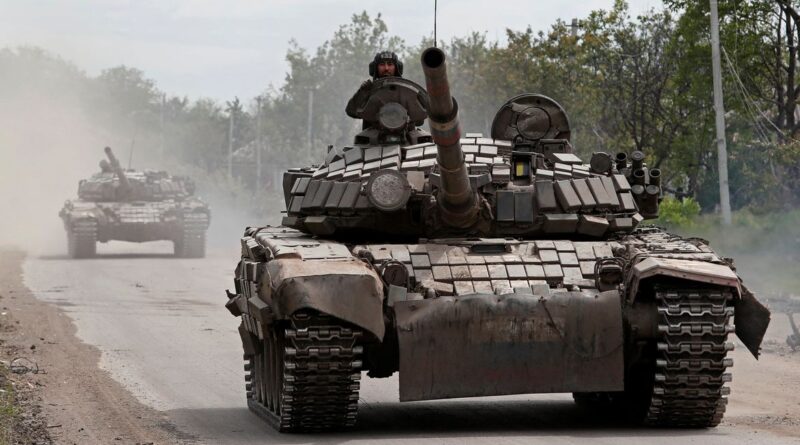The dangerous game of red lines in Ukraine
BRANKO MARCETIC
When the United States becomes militarily involved in a conflict, it often finds it difficult to get out, let alone avoid deep entanglements that far exceed the lines it had drawn at the outset of the intervention.
It happened in vietnam, when American military advisers helping the South Vietnamese fight the Viet Cong eventually became American soldiers fighting an American war. It occurred in Afghanistan, when an initial invasion to capture al-Qaeda and topple the Taliban morphed into a nearly two-decade nation-building project. And it could be happening right now in Ukraine.
Little by little, NATO and the United States are approaching the catastrophic scenario that President Joe Biden warned of “they had to make an effort to prevent”: a direct conflict between the United States and Russia. Despite emphasizing at the start of the war that their forces "are not and will not be involved in the conflict," current and former intelligence officials they told the Intercept in October that “there is a much larger US and CIA special operations presence” in Ukraine than when Russia invaded, carrying out “clandestine US operations” in the country that are “now much more extensive”.
Among those clandestine operations, investigative journalist and former Green Beret Jack Murphy reported on December 24 amid scant mainstream media attention, that CIA work with an unidentified NATO-allied spy agency to carry out sabotage operations inside Russia was allegedly the cause of the unexplained explosions that rocked the Russian infrastructure during the war. This is the kind of activity that comes dangerously close to a direct confrontation between NATO and Russia.
To put it in perspective, remember the way that sectors of the political establishment from the United States saw the mere act of Russian meddling in the 2016 election as a " act of war “: scandalous, but much less serious than helping to carry out infrastructure attacks on the soil of another country.
Meanwhile, the United States and its NATO allies have vastly surpassed its own self-imposed lines on arms transfers. At the start of the war, the New York Times warned that the open supply of even small arms and light weapons "risks encouraging broader warfare and possible retaliation" by Moscow, while US officials ruled out more advanced weaponry as contributing too much to escalation. It took the Biden administration less than two months start shipping that category of high-powered weapons with more risk.
At the end of May, I was Sending advanced rocket systems that only a few weeks before had considered too much climbers, with the strict condition that Ukraine did not use them to attack inside Russian territory, something that they feared could lead to an escalation, until that line was finally breached as well. The Pentagon admitted last December that it had finally given Ukraine the go-ahead to strike targets in Russia, in response to Moscow's destruction of Ukrainian infrastructure.
"The fear of escalation has changed from the beginning," a defense official explained to the Times of London, with the Pentagon less concerned since Russian President Vladimir Putin , withdrawal its nuclear threats in October.
As the Ukrainian war effort has stalled and Russian forces have made small strides, NATO arms transfers have now risen far beyond what governments feared a few months ago that could drive the alliance into direct war with Russia, with US and European governments now sending armored vehicles and deciding to send tanks . Ukraine's Defense Minister Oleksii Reznikov had predicted this in October last year.
"When I was in DC in November, before the invasion, and asked for Stingers, they told me it was impossible." said then to the New Yorker. "Now it is possible. When I asked for 155-millimeter guns, the answer was no. HIMARS, no. DAMAGE, no. Now all of that is a yes. Therefore, I am sure that tomorrow there will be tanks and ATACMS and F-16s.
It remains to be seen how long before the american opposition to such military aid follow the path of its previous opposition to the heavy weapons it has already sent, or how long the administration will continue to resist long-range drones, which a bipartisan group of senators is currently pressing, what that Russian officials have explicitly warned that would make Washington "a direct party to the conflict."
As the nature of arms transfers has broadened, so have the objectives of war. The initial goals of the alliance were to help Ukraine defend its independence and sovereignty by repelling a Russian invasion bent on regime change. Two months later, US officials they spoke publicly of " victory ” and inflicted a “strategic defeat” on Russia that would leave it “weakened”. Biden has promised in repeatedly support Ukraine "for as long as necessary," including when Zelensky and other officials he left in clear on repeatedly that their goals now are to retake the Crimea, something that could trigger a nuclear escalation.
Talk of diplomacy is once again all but absent from American commentary on the war, outnumbered by called to escalation drastic of NATO's involvement in achieving victory for Ukraine, often on the basis of basis that any other outcome would deal an existential blow to the West and the entire liberal world order.
"If Russia wins the war in Ukraine, we will see decades of this type of behavior ahead of us," he said recently in Davos. Finland's progressive Prime Minister Sanna Marin as she compromised to support Ukraine's war effort for 15 years if necessary. “We have to make sure that, in the end, the Ukrainians win. I don't think there is any other option."
And it seems that as of last week, the Biden administration is ready to cross another important line, with the New York Times. informing that US officials are seriously considering giving Ukraine the green light to attack Crimea, even while acknowledging the risk of nuclear retaliation such a move would entail. Fears of such an escalation "have subsided," US officials told the newspaper.
By increasing their support for the Ukrainian military, the US and NATO have created an incentive structure for Moscow to take a drastic and aggressive step to show the seriousness of its own red lines. This would be dangerous at best, but particularly when Russian officials make it clear that come each war again like a war against NATO as a whole, not only against Ukraine, while threaten with a nuclear response to escalating alliance arms deliveries.
NATO governments increasingly paint the conflict before their publics not as a limited effort to help one country repel an invasion by a larger neighbor, but rather as an existential battle for the survival of the West, reflected in the Russian leaders' own evolving view of the war as a battle for survival against hostile Western powers. Notably, this has happened despite the Biden administration's public endorsement of diplomacy late last year.
If the intention is to keep this war as a limited regional war between two neighboring NATO states playing only a supporting peripheral role, all these trend lines point in exactly the opposite direction. Unless officials make a concerted effort to de-escalate and pursue a diplomatic track and prominent voices in media and politics create the political space for them to do so, Biden's promise to avoid World War III will mean as much as the President Johnson's promise in 1964 not to "send American boys nine or ten thousand miles from home to do what Asian boys should be doing for themselves."
Branko Marcetic He is an American journalist. He is the author of the book Yesterday's Man: the Case Against Joe Biden.
This article is published in cooperation with the American magazine Responsible Statecraft










Pingback: The dangerous game of red lines in Ukraine | NR | alternative journalism